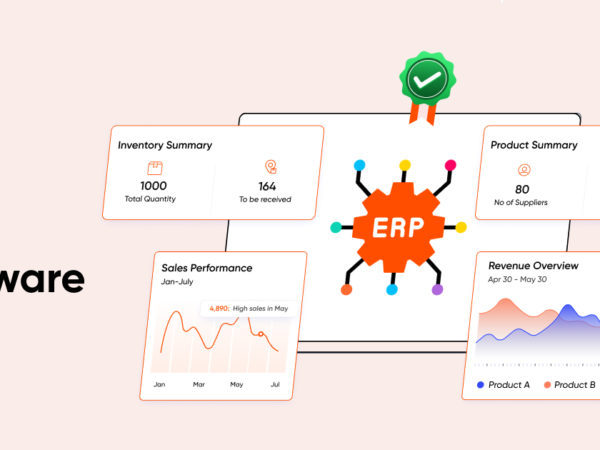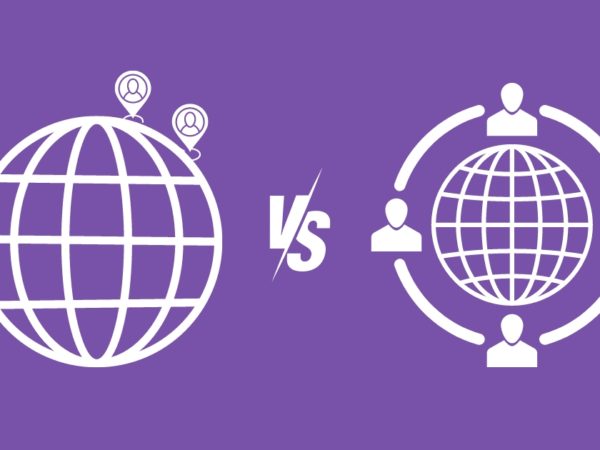Leverage green tech in your business for sustainable growth and contribute positively to the long-term good of the natural environment.
Conventional technology like mining fossil fuel, thermal electricity, greenhouse gases for cooling, plastic wrappers, pesticides in farming fields, etc., have caused extensive environmental damage.
Pollutants like CO2 and other greenhouse gases have been raising the earth’s average temperature rapidly since the industrial revolution.
Businesses and entrepreneurs must take a stance to put an end to this destruction of nature by adopting green tech in their respective industries.
What Is Green Tech?
<img alt="YouTube video" data-pin-nopin="true" data-src="https://kirelos.com/wp-content/uploads/2022/12/echo/hqdefault.jpg63a428a8c3178.jpg" height="360" src="data:image/svg xml,” width=”480″>
Green tech is a niche of technology processes, methods, and products that do not impact the environment negatively. From a production, storage, supply chain, consumption, and disposal point of view, you add no extra carbon, other pollutants, or heat to the surrounding environment.
Green tech has many names in the industry, and these are as follows:
- Sustainable Technology
- Green Technology
- Environmental Technology
- Clean Technology
- Climate Tech
- Clean-Energy Tech
Additionally, any technology that does not add extensive pollution and carbon to nature and helps to mitigate the risk of carbon emission is also considered a branch of green tech.
You will see climate tech mostly utilizes the following processes to reduce the CO2 and heat burden of the earth:
- Increase the natural storage of carbon via tree plantation, horticulture research, algae farming, etc.
- Capture methane and other polluting gases from landfills for industrial or residential use.
- Disposal of landfill toxic, industrial effluents, residential waste, etc., in an environment-friendly manner.
- Innovate novel industrial processes that require less energy, space, and workforce for production, supply chain, storage, etc.
- Invest in agricultural research to increase crop production per hectare and save forests from the need for deforestation.
- Increase awareness among global citizens to help businesses and governments with environmental protection and healing.
Next, we will explore the importance of Green Tech.
Importance
Green Tech is important to generate processes to minimize emissions that other technologies produce. It will also show the human race ways to discover new technologies that do not impact the environment drastically, like coal-fired electricity plants, fossil fuel-driven cars, energy-hungry data centers, etc.
Components of Green Tech, like clean tech, climate tech, etc., will offer new processes and workflows to stop further degradation of nature at the rate we see today. Heal nature by exploring innovative and novel technology concepts that are cost-effective and easy to implement.
Every business must adopt Green Tech or invest in sustainable technology to contribute directly or indirectly to the environment.
Green Tech Vs. Clean Tech
Both Green Tech and Clean Tech help us to fight climate change, restore nature, and grow sustainably. However, there are some fundamental differences which as below:
| Features | Green Tech | Clean Tech |
| Resource Usage | Promotes minimal resource usage. | Promotes efficient resource usage. |
| Environmental Impact | Reduces environmental impact by conserving natural resources like water bodies, forests, fossil fuels, etc. | Reduces environmental impact through technology like energy-efficient lighting, low-energy network devices, minimal industrial discharge, etc. |
| Environmental Elements | It focuses on all sorts of elements that compose nature. | Focuses on specific natural resources like water, air, etc. |
| Industrial Processes | Impacts industrial processes by reducing resource usage and promoting recycling. | Impacts industrial processes by increasing efficiency, performance, and productivity. |
Goals
The main objective of green tech is to help other technologies achieve sustainable growth without damaging the surrounding environment in the long term. Other notable goals of sustainable technology are as below:
#1. Create a Balance of Energy Sources
Reduce the usage of non-renewable energy so that the volume of consumed non-renewable energy matches the renewable energies used by the industries.
#2. Save Renewable Energy Sources
Control the consumption of renewable energy to a level where it does not cross its production volume.
#3. Save Nature From Over Exploitation
Function as a technology process to ensure human and industrial activities do not exceed nature’s regeneration and absorption capacity.
#4. Creating Clean Energy
Ensuring easy access to reliable, modern, sustainable, and affordable energy.
#5. Energy Efficiency
Improving the energy efficiency of all conventional and new-age industrial processes to reduce emissions and energy intake.
#6. Push for Renewable Energy in all Industries
Increasing the portion of renewable energy in the global mix of all types of energy consumption.
#7. Reduce Business Costs
Provide better performance and production capacity of business processes at lower costs.
#8. Promote the Conservation of Resources
It helps industries and households to use natural resources responsibly and efficiently with zero waste. It will also look for ways to reduce pollution, waste, and consumption of resources.
#9. Sustainable Technology Research
Innovate sustainable technologies that fulfill the need of global consumers without affecting nature.
#10. Replace Old Processes
Seek out existing processes that harm the environment and replace them with innovative processes that do not damage the environment at the same rate as the old process did.
#11. Cradle-to-Cradle Production
Promote and provide production processes that will produce goods that can be recycled more easily than existing goods with only one-time use, popularly known as the circular economy.
Examples of Real-World
Green Coding
Longer computer codes mean lengthier run times and greater energy consumption. Hence, computer scientists are betting on green coding.
Green codes are small programming algorithms that deliver more computation than lengthier codes. Programmers consider Rust, C, C , Java, and Ada green coding languages.
Green Computing
Green computing uses computational power, hardware, software, etc., in an energy and resource-efficient way. It advocates for energy-efficient devices, recyclable hardware, better device lifespan, expert power management, etc.
Plastic Roads
MacRebur produces plastic roads and plastic-based additives to improve the asphalt used in road construction. It sources its plastic from the environment and thus reduces pollution caused by non-disposable plastics. It does not produce new plastics and hence is a carbon-neutral process.
Plant Walls
Green Fortune produces various plant-based home and office space decoration products. It also manufactures plant walls that are smart in irrigation, lighting, air purification, and self-surviving.
Outdoor plant walls will help minimize building heat, capture rainwater for harvesting, and provide a safe habitat for insects that help nature heal.
Solar Flowers
Smartflower Solar, a Boston-based renewable energy innovator and producer, manufactures all-in-one portable solar power stations. You can use DIY tools to change the position of the solar station according to sunlight availability.
It produces 4,000 – 6,200 kWh of energy per year, enough to sustain a household in the US for 6 months and a household in Europe for the whole year.
Waste Water Treatment
Advanced biological component-based water treatment helps industries and residential complexes clean their wastewater. The treated water is so clean that you can reuse it directly for washing and cleaning purposes.
Solar Roofs
Tesla Solar Roof comes with roof tiles that inherently produce electricity from sunlight using built-in photovoltaic cells. Solar roof tiles last up to 25 years, significantly minimizing the overhead cost.
The solar roof can run the whole house and charge the Tesla Powerwall for outages and backup. With such a green tech product, you do not need to experience the hassles of maintaining ad-hoc solar panels that require heavy maintenance.
Benefits
- Green Tech and allied technologies will help us heal the environment to a state where it can sustain the long-term growth of global economies.
- Reduce the load on fossil fuel and nuclear power and pave the way for safer and cleaner energy that does not harm nature.
- Minimize resource consumption load.
- Create more jobs, allied businesses, and supply chains, and sustain the world’s economic growth.
Next, we will discuss the various challenges of Green Tech.
Challenges
#1. Research and Development
Most green tech products and concepts are in the R&D state. They need more research to arrive at the production level.
#2. Lack of Investments
Businesses know very well that global warming, arctic ice melting, and climate change will limit the profitability of conventional industries. Still, investors are not investing enough in green tech.
#3. Vast Population
The huge population of the globe demands faster delivery of consumables, energy, and healthcare. It can not alone meet the demands of an ever-increasing global population.
#4. Fossil Fuel-Based Economies
Many fossil fuel-based economies promote the consumption of conventional energy sources so that these economies can sustain themselves.
#5. Lack of Experts
Green tech demands experts and talents who can carry out research and development. On the contrary, the world population supplies mostly unskilled laborers who can not effectively participate in green tech innovations.
Future Scope
According to Allied Market Research, the green tech market size was $10.32 billion in 2020. The same report suggests that this tech domain will become a $74.64 billion industry by 2030.
Most of these investments will be in the markets of North America, China, and Europe. Furthermore, a large chunk of investments in green tech will go to the following industrial processes:
- Carbon capture and storage
- The global renewable energy industry
- Offshore wind power market
In the upcoming years, the following green tech processes will see the most growth, job creation, and return on investments (ROI):
- Technology to capture carbon and store it in synthetic fuel.
- Construction of living spaces, offices, warehouses, and shopping malls will emit little to no carbon throughout their lifespan.
- Creating advanced storage or batteries to capture and store renewable energy for future use.
- Hydrogen fuel cell and hydrogen-powered vehicle development and making these mainstream to reduce carbon and heat emission to zero from transportation.
- Promotion of circular economy to produce more durable and long-lasting products. Also, use old products to make other useful commodities and minimize waste.
Next, we will explore the best resources to learn about Green Tech.
Resources
There is a lot more to learn about climate tech. You can check out these resources for convenient learning:
Green Tech: How to Plan and Implement
You can save money and resources by implementing sustainable IT solutions. The book on Green Tech helps you to learn sustainable IT from planning to implementation effortlessly.
In the end, you will be able to achieve reduced energy consumption and stop releasing toxic elements to nature for your business.
Green Technology: An A-to-Z Guide
Green Technology: An A-to-Z Guide discusses the responsibility and role of technology in developing a sustainable environment. It also discusses the latest innovations and uses cases in the green tech domain.
The book covers articles from various scientific niches like biochemistry, nanoscience, IT, and environmental engineering. The main focus of the book is waste management.
Green Technologies (PB)
The Green Technologies (PB) talks about the present development in the green tech domain. It also covers global warming theories from the fundamental level.
In the end, the book grooms you to understand green technologies up to a level where you can make business decisions.
Solving the Climate Crisis (Green Tech)
Solving the Climate Crisis helps you understand the long-term environmental impact of the cutting-edge technologies we use today. It also talks about various next-generation sustainable and climate technology concepts that will help humankind create a greener, cleaner, and safer world.
The book does not just talk about cutting-edge clean tech but also discusses century-old technologies that help battle climate change, global warming, and more. If you are a professional or business manager brainstorming for novel concepts of green tech, then you should read this book.
Author’s Note
Green tech will help businesses grow sustainably in the long term when industry leaders and communities understand the value of balancing carbon emissions with carbon remission. Only green tech can help the world offset its carbon footprint for a greener environment.
You can leverage green tech for profit-making ventures as a career seeker, business, or entrepreneur. You can help industries plan their carbon footprint minimization or sell green tech products ready to be deployed in industrial premises.
Now you know various aspects of green tech from definition to implementation and real-world use cases. You’ve also explored some reliable resources to learn green tech so that you can apply it in your business or profession.
Next, check out the best Environmental Health and Safety (EHS) management software.



